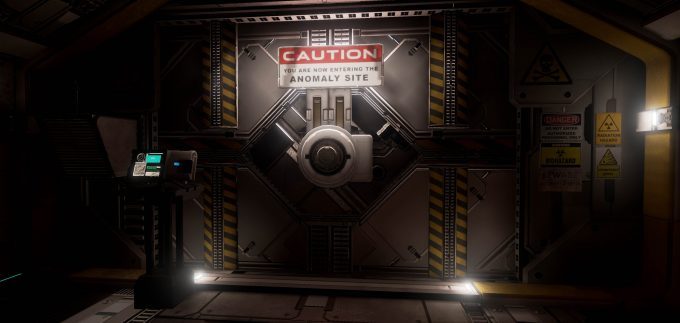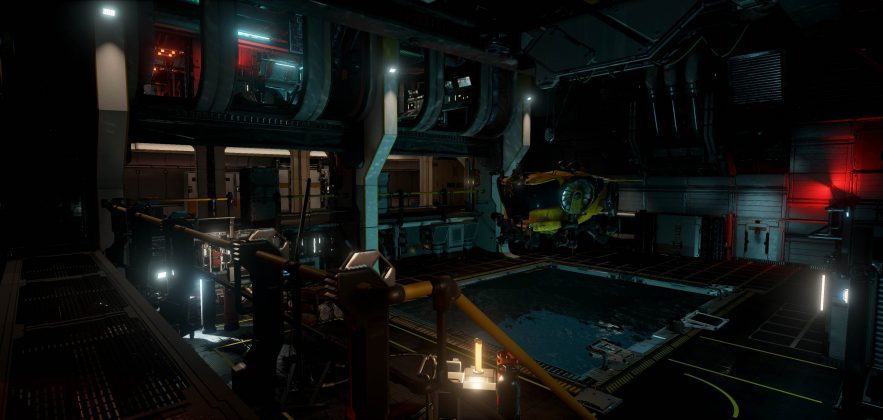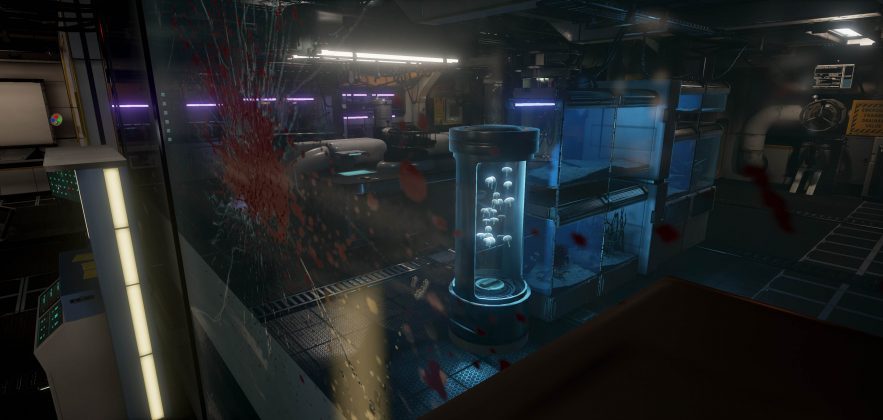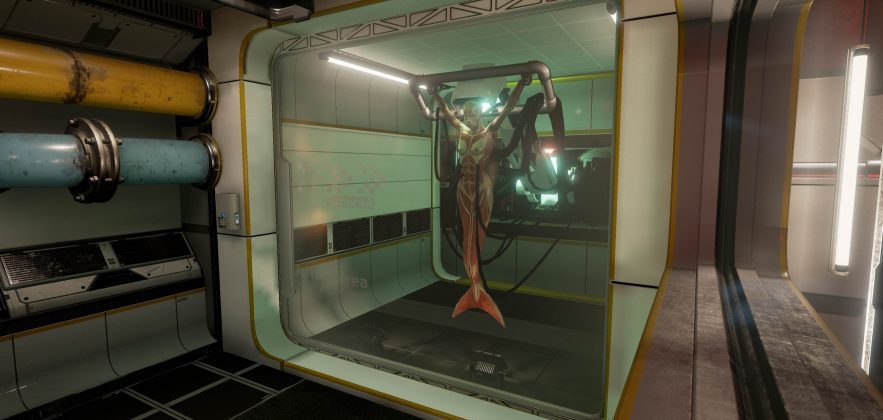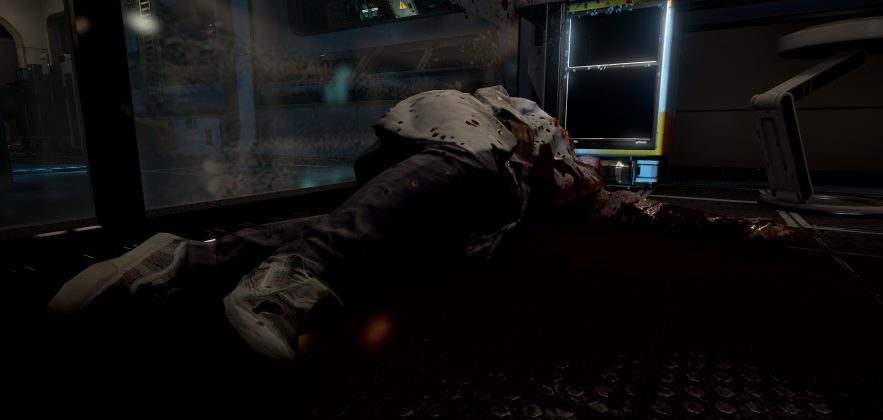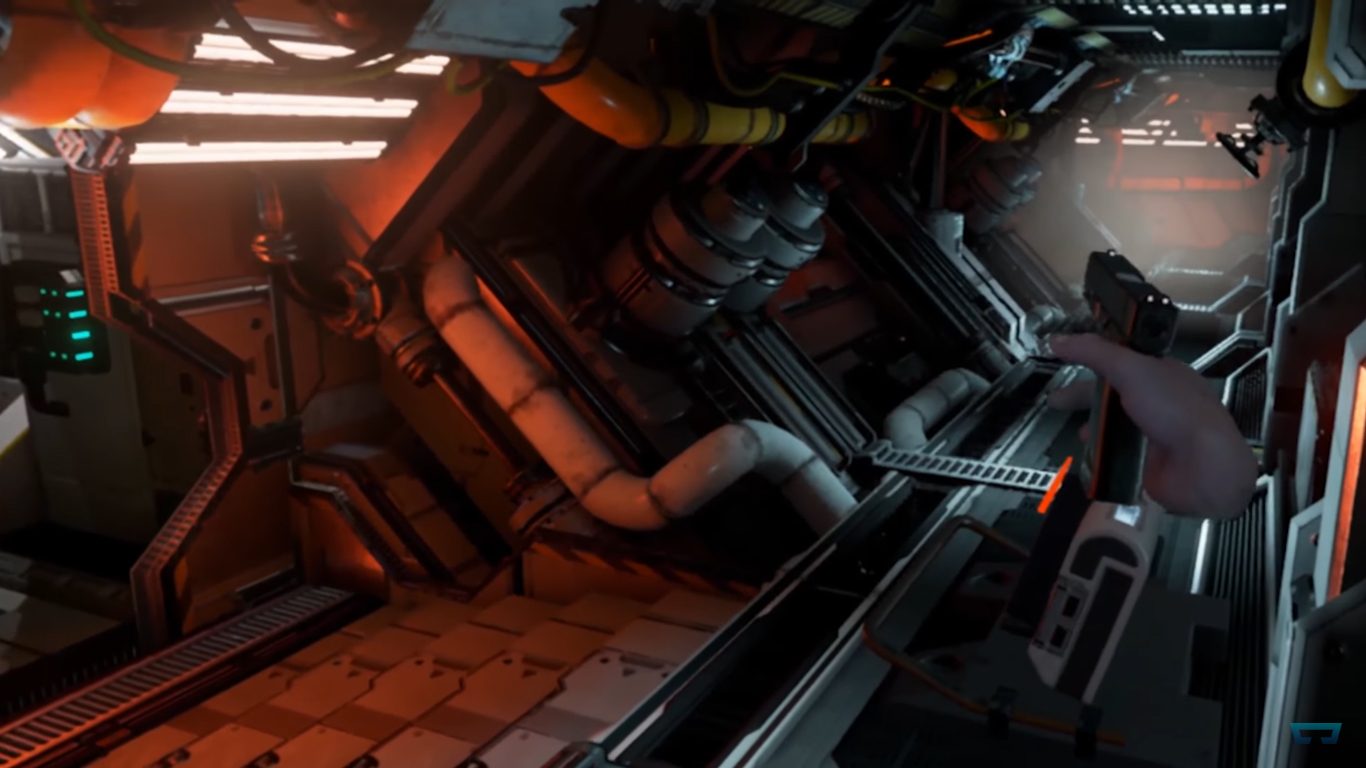SYREN (2017) is a single-player, survival-horror game that will have you sneaking around corners, hiding under virtual desks, and flailing helplessly as you’re mauled to death by the world’s ghastly “Syrens,” a terrifying amalgamation of human/robot/awfulness. Despite some pretty distracting bugs in the game, it’s safe to say that people with high blood pressure or heart conditions need not apply.
SYREN Details:
Developer: Hammerhead VR
Available On: Oculus Touch, HTC Vive (Steam and Oculus Home)
Reviewed on: HTC Vive and Oculus Rift
Release Date: February 15th, 2017
Update 02/16/17: Hammerhead VR originally provided us with a Steam code for review purposes. After publishing the review, the studio informed us that the Steam code was actually for an older version of the game, and that many of the bugs we encountered had already been fixed. Furnished with a new Oculus Store code, we were able to verify that many of the bugs, at least for the Rift version (originally detailed in the ‘Immersion’ section of the review) including difficulty with Touch’s control scheme, virtual hand position, and shooting guns, were indeed fixed. The issue of ‘wall-hacking’ was also addressed to a large degree, as physically moving through walls will entirely black out your vision. Some architecture, like support beams and furniture can however still be used in this manner for cover.
Because we believe this was an honest mistake on the part of the studio, we’ve altered the ‘Immersion’ score to reflect the changes, which in turn has pushed the overall score up by a half-point. You’ll find the original article below with an asterix (*) appended to the few sections where bugs had either been completely fixed, or addressed in some way by the studio.
Gameplay
Much like Alien: Isolation (2014), Syren is an absolutely terrifying game of hide and seek, but this time instead of the claustrophobic world of a spaceship and an acid-spitting Xenomorph, you’re in an underwater research facility placed above an ancient lost city once populated by a species of kind-of-sexy, kind-of-horrific mermaids—at least they were supposed to be, as the creatures you meet are genetically engineered copies called Syrens.
Created by a scientist obsessed with eugenics, your job is to escape the now damaged facility that’s become overwhelmed with the free-roaming Syren, going across a number of levels filled with deceased colleagues and all manner of interactive items that can bring you ever closer to the 5-level facility’s next pressurized door.
Each level is essentially a puzzle with a few different solutions, from nabbing a keycard off a desk and sneaking past a lonely Syren, to all-out shoot-em-up chaos with multiple baddies as you learn the mystery of the madman who created the facility.
The game has a very specific idea of how it wants you to proceed, something I found to be slightly frustrating early on. After getting killed multiple times by the same Syren and getting tossed back to the beginning of the level, I found out that when they lunge at your throat, you can’t simply whack the beast to death with an ax that you collected earlier like you naturally would if someone was coming at you and you had a melee weapon in hand. Rather, the game wants you to physically throw the ax, thereby losing it in the thing’s face so the game can leave you without a weapon for the next trial. The only way you can figure this out is either by having the original thought to toss the ax, or by failing your way to the solution like I did.
Although there’s a steep learning curve to how you interact with the Syren (mostly by staying far away from them, running and hiding for your life), eventually the game becomes a little more intuitive as you learn the rules that the AI Syren abide by. For example, if a Syren gets close enough to you, it initiates an uninterruptible attack that you have to stomach—a wailing monster screaming in your face and biting your neck—so you learn to avoid these pants-shitting moments as best you can, otherwise you’ll be sent back to the beginning of the level.
You can get away from Syrens by hiding stealthily, teleporting quickly to find cover, or by distracting them by throwing items far away from you to take them off your track. Since the monsters react to noise (and strangely enough not your voice via the headset’s microphone), they will scream over to where the object landed, only to find no one there, giving you some time to dodge around them. There are however multiple Syrens per level, so this is where it gets tricky.
Several times I found myself hiding under a desk, or behind a dead body for cover, all the while hearing the banshee screams and heavy breathing of the genetically engineered monsters coming my way. And if it weren’t enough of a fright, no matter where they find you, cowering in a corner or halfway outside of a locker, they always grab you by the face and scream a horrifying noise into your ears.
Immersion
The Syrens make a lot of noise, which should be a good thing on principle so you can avoid them efficiently, but the noise wasn’t at all muffled by objects like walls or barriers like in real life. If you find yourself sandwiched in a side room with two Syrens slinking around and breathing all scary-like, you won’t have a good idea of realistically where they are. Instead, a Syren will sound like they’re right on top of you even though you have a concrete wall between you.
Whether you’re using Oculus Touch or the Vive’s Lighthouse controllers, hands simply aren’t centered 1:1, making them seem a full three inches away from where your hands naturally rest on the controllers. While it’s not game-breaking, it certainly hampers immersion. In the end, this isn’t something dramatic to fix, but how such a critical immersive error got through on launch, I’m just not sure.*
On the note of controllers, Oculus Touch support could be a lot better. The game requires you to push down and click on the joystick to teleport, which proves to be just about as awkward as can be. Teleporting is much more intuitive on the Vive, requiring you to simply rest your thumb on the touchpad and engage a quick click, but Rift users beware.*
Firing guns in the game unfortunately never felt natural on either Touch or Vive controller, as your index-trigger is used to pick up and hold items and a regular button press is used to activate or fire it. This made it feel more like changing the channel on a remote control than firing a gun.*
And this is the part of the article where I make my biggest confession. I am a dirty, no good, wall-hacking cheater.*
Because the game is room-scale, it means you can teleport close to walls and actually walk through them. Some games like Budget Cuts or Onward (2016) don’t allow you to do this, either by making it impossible to see or leaving your body behind to be ravaged by enemies, but not so with Syren. When a screaming water-banshee is running you down, and you can walk straight through a wall and escape—the natural choice is to flee anyway the game will let you. While I know I’m a weak and shameful person for using this cheat to get away, it really shouldn’t even be an option in the first place.
There, I feel better now.
Comfort
While you’ll never be truly comfortable with genetically modified mermaid-beasts skulking around, nuts and bolts-wise Syren is a supremely comfortable experience because it lets you explore the world using teleportation and 45 degree snap-turning—two common locomotion schemes that most everyone shouldn’t have a problem in the nausea department.
Even though at times I honestly wish I could sit down and mash a joystick forward on a gamepad instead of frantically selecting a place to teleport—because it’s not only faster, but easier—the standing room-scale aspect of the game lends to overall comfort and immersion. And somehow it’s always scarier that way, as you’re on your hands and knees hiding behind something and hoping the monster doesn’t see you.
 We partnered with AVA Direct to create the Exemplar 2 Ultimate, our high-end VR hardware reference point against which we perform our tests and reviews. Exemplar 2 is designed to push virtual reality experiences above and beyond what’s possible with systems built to lesser recommended VR specifications.
We partnered with AVA Direct to create the Exemplar 2 Ultimate, our high-end VR hardware reference point against which we perform our tests and reviews. Exemplar 2 is designed to push virtual reality experiences above and beyond what’s possible with systems built to lesser recommended VR specifications.


